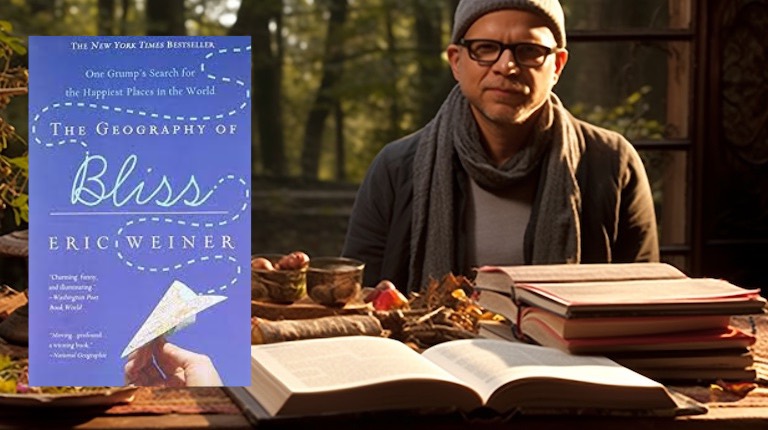The Geography of Bliss takes readers on an engaging expedition
“The Geography of Bliss: One Grump’s Search for the Happiest Places in the World” by Eric Weiner is a captivating exploration of happiness and its connection to geography. In this thought-provoking book, Weiner, a self-proclaimed grump, embarks on a global journey to uncover the secrets behind the happiest places on Earth. With an engaging writing style and a witty sense of humor, he challenges conventional notions of happiness and digs deep into cultural differences to understand what truly makes people happy.
As Weiner travels from country to country, he immerses himself in unique cultures that offer contrasting perspectives on happiness. Whether it’s the contentment found in Bhutan’s Gross National Happiness index or the laid-back approach to life in Thailand, Weiner encounters fascinating insights along his quest. Through his observations and interactions with locals, he discovers that there is no one-size-fits-all definition of happiness.
Overview of the book and author’s purpose
In “The Geography of Bliss: One Grump’s Search for the Happiest Places in the World,” author Eric Weiner embarks on a journey to explore what makes certain countries and cultures happier than others. With a mix of travelogue, memoir, and self-help book, Weiner takes readers on a witty and insightful adventure as he visits places like Iceland, Bhutan, Switzerland, and India in search of happiness.
Through his encounters with locals and experts on happiness, Weiner delves into the various factors that contribute to overall life satisfaction. He examines cultural values, government policies, social relationships, and even climate conditions to understand how they shape happiness levels in different societies. Along the way, he shares personal anecdotes and engaging conversations that shed light on people’s perspectives towards joy and contentment.
Weiner’s purpose is not only to entertain readers with his humor-filled storytelling but also to challenge common assumptions about happiness. By exploring diverse cultures’ approaches to well-being while confronting his own skepticism along the way, he encourages readers to reconsider their own pursuit of happiness. Ultimately, “The Geography of Bliss” offers an enlightening perspective on what it means to be happy and prompts us to question our preconceived notions about how we can achieve it.
The Quest for Happiness: A Global Journey
In his book “The Geography of Bliss: One Grump’s Search for the Happiest Places in the World,” Eric Weiner embarks on a global journey to understand the concept of happiness. The author, a self-proclaimed grump, travels to various countries such as Bhutan, Switzerland, Iceland, and Qatar in search of the happiest places on Earth. Throughout his journeys, Weiner explores different cultural perspectives on happiness and delves into what factors contribute to overall well-being.
Weiner discovers that Bhutan’s focus on Gross National Happiness rather than Gross Domestic Product has led to a society that values contentment and spiritual well-being. In Switzerland, he explores how their high quality of life stems from their strong sense of community and work-life balance. On his visit to Iceland, Weiner learns about resilience and adaptability through the country’s unique approach to dealing with their harsh environment.
Through his travels, Eric Weiner provides readers with insights into how different cultures define and pursue happiness. By examining these diverse perspectives, readers are encouraged to question their own notions of happiness and consider alternative paths towards finding joy in life.
Unveiling the Secrets of Happiness: Lessons Learned
In his book “The Geography of Bliss: One Grump’s Search for the Happiest Places in the World,” Eric Weiner explores various countries to uncover the secrets of happiness. Through his travels, Weiner discovers that happiness is not a one-size-fits-all concept but rather a subjective experience influenced by culture, environment, and individual mindset.
One lesson learned from Weiner’s journey is that happiness is not dependent on material possessions or wealth. In Bhutan, he encounters a country that measures its success based on Gross National Happiness rather than Gross Domestic Product. This alternative approach emphasizes the importance of spiritual well-being, community connections, and environmental sustainability as factors contributing to overall happiness.
Another valuable insight from Weiner’s exploration is the significance of social relationships in cultivating happiness. In Iceland, despite harsh weather conditions and isolation from mainland Europe, people report high levels of contentment due to their strong sense of community and support networks. The emphasis on spending quality time with loved ones and fostering deep connections highlights how human interaction plays an integral role in achieving lasting happiness.
Overall, “The Geography of Bliss” teaches us that true happiness cannot be found through external validation or material possessions instead, it stems from within ourselves and our ability to cultivate meaningful relationships with others while finding purpose in life.
Case Studies: Exploring Different Cultures’ Perspectives on Happiness
In “The Geography of Bliss: One Grump’s Search for the Happiest Places in the World,” Eric Weiner embarks on a journey to uncover the key to happiness by exploring different cultures’ perspectives. Through a series of case studies, he delves into countries known for their happiness and examines what sets them apart.
One such case study takes us to Bhutan, a small Himalayan kingdom that measures its success through Gross National Happiness (GNH) instead of GDP. This unique approach prioritizes environmental preservation, cultural promotion, and spiritual well-being. Weiner explores how Bhutan’s emphasis on community and interconnectedness contributes to the overall happiness of its citizens.
Another intriguing case study focuses on Denmark, consistently ranked among the world’s happiest nations. Weiner delves into the Danish concept of hygge – a feeling of coziness and contentment derived from simple pleasures and quality time spent with loved ones. He uncovers how this cultural practice fosters strong social connections and promotes mental well-being.
Overall, “The Geography of Bliss” offers fascinating insights into various cultures’ perspectives on happiness through these engaging case studies. It challenges readers to reconsider conventional notions of success and encourages exploration beyond material wealth as an indicator of contentment.
Critiques and Controversies: Debating the Book’s Findings
Critiques and controversies surrounding the book’s findings in “The Geography of Bliss: One Grump’s Search for the Happiest Places in the World” have sparked intense debates among readers and experts alike. While some applaud Eric Weiner‘s unique approach to exploring happiness through a global lens, others question the validity of his findings and methodology.
One common critique revolves around the subjective nature of happiness itself. Critics argue that defining and measuring happiness is a complex task, as it varies greatly across cultures, individuals, and even within different stages of life. They assert that Weiner’s attempt to quantify happiness using factors such as GDP or life expectancy may oversimplify its multifaceted nature, leading to biased conclusions.
Moreover, controversy arises from Weiner’s selection of countries for his research. Some argue that his focus on predominantly affluent nations like Switzerland or Bhutan neglects regions facing significant socio-economic challenges. Critics claim this skewed sampling prevents a comprehensive understanding of global happiness patterns and undermines the book’s overall credibility.
Overall, while “The Geography of Bliss” offers intriguing insights into what makes people happy around the world, it is not without its fair share of critiques and controversies. The subjective nature of happiness measurement and potential biases in country selection are key points fueling these debates. However, they also serve as an invitation for further exploration into understanding well-being on a broader scale beyond traditional metrics alone.
Conclusion: Reflection on the Impact of Happiness Exploration
In conclusion, “The Geography of Bliss” by Eric Weiner offers a thought-provoking exploration into the concept of happiness and its varying manifestations across different cultures. Through his witty anecdotes and insightful observations, Weiner takes readers on a journey to some of the world’s happiest places, including Iceland, Bhutan, Switzerland, and Thailand.
One key takeaway from this book is the realization that happiness is not solely dependent on external factors such as wealth or material possessions. Instead, it is deeply rooted in cultural norms and values that shape individuals’ perceptions of what brings them joy. For example, in Bhutan, where Gross National Happiness is prioritized over Gross Domestic Product, people find contentment in simplicity and spiritual pursuits rather than materialistic pursuits.
Moreover, “The Geography of Bliss” highlights the importance of human connections and social relationships in fostering happiness. From the tight-knit communities of Iceland to the communal living practices in India’s slums, Weiner emphasizes how genuine human interactions can contribute significantly to one’s overall well-being.
Overall, Eric Weiner‘s exploration into happiness serves as a reminder that there are various paths to finding contentment in life. By delving into different cultural perspectives on happiness and reflecting upon our own values and priorities, we can gain a deeper understanding of what truly matters to us individually and collectively.












